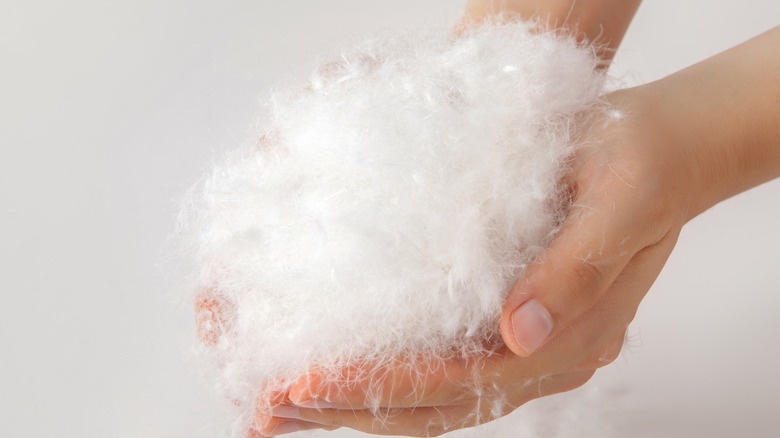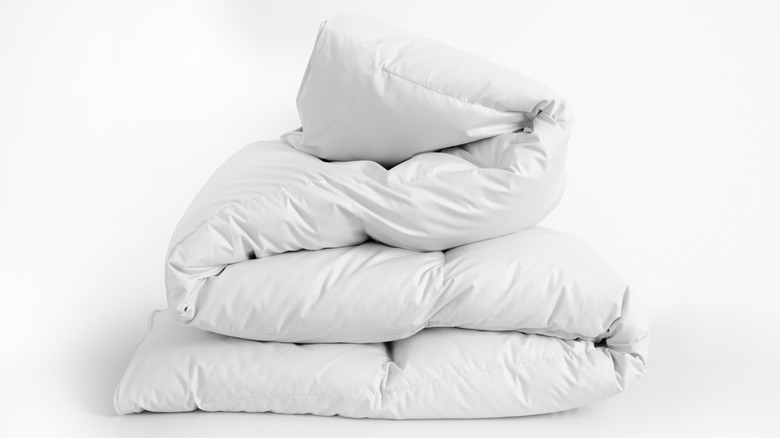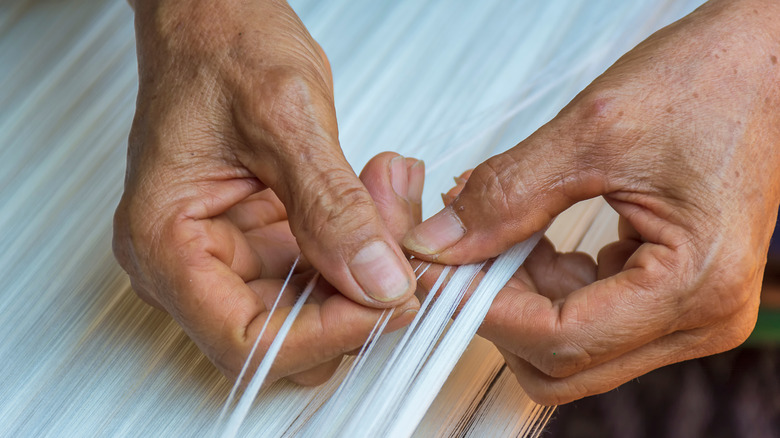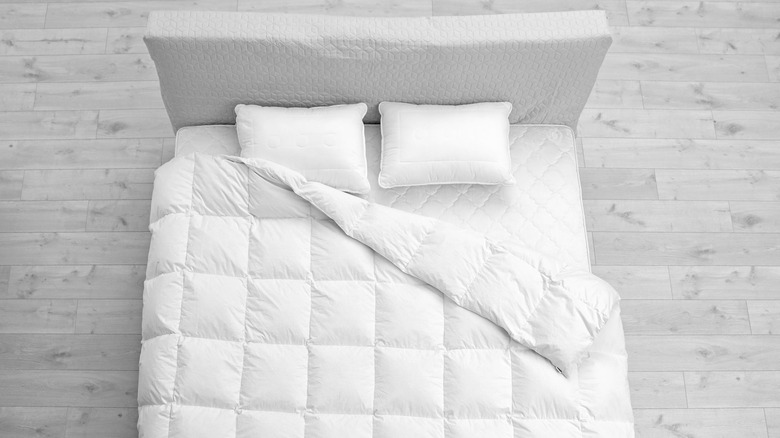Duvets: Everything You Need To Know Before You Buy
When you find the right duvet, you'll feel like you're sleeping in a cloud. Duvets provide a warm and cozy top layer and can be used year-round, depending on the style.
Before diving into everything you need to know about duvets, let's start with terminology. There's often some confusion because duvets may also be referred to as comforters or duvet inserts. Technically speaking, a comforter is generally made with a synthetic filling and includes a built-in, decorative cover. A duvet, on the other hand, is typically filled with natural materials and is designed to be paired with a duvet cover, which protects the insert and makes laundering your linens easier. Brooklinen's Head of Product Development Katie Elks, in an interview with Martha Stewart, said, "since comforters and duvets are often difficult to wash given their bulky size, duvet covers can protect the comforter or duvet and make it easier to care for." Most duvet inserts feature white shells and can be used without a cover, though it's not typically recommended.
While there are many similarities from product to product, not all down comforters perform similarly. In fact, there's nearly endless room for variation depending on the shopper's budget, bed size, climate, and sleep preferences. Elks explained that down comforters are, "available in different weights and fill options, they can be customized to suit your comfort levels and sleeping needs." Before you begin shopping for a down comforter, it's important to know the key considerations to keep in mind before you make a purchase. This guide will explain everything you need to know before you buy a duvet.
Natural fillings
When shopping for a duvet, perhaps the most important factor is the filling. The highest-quality duvets are filled with down or feathers. Associate professor of apparel and design at St. Catherine University in Minnesota Anupama Pasricha explained to NBC News that down is the "undercoating or under feathers of duck or geese." This fluffy material helps keep waterfowl warm in cold, damp weather, making it an excellent choice for creating well-insulating bedding.
While some duvets are filled with 100% down, many feature a combination of down and feathers. According to the Down & Feather Co., down is more expensive to source than feathers but feels softer and fluffier and is longer lasting. One major downside of duvets that include a feather filling is that they contain quills, which may poke out of the shell and prove to be uncomfortable. It's important to verify the duvet's label because while a product may be marketed as a "down duvet," it may be filled with 10% down and 90% feathers.
Shoppers face more choices when choosing between down and feathers from either geese or ducks. Goose down is considered to be the gold standard because geese are larger animals and therefore have larger clusters of down. Geese are also native to colder climates and have developed ultra-warm down as a survival mechanism. Feathers and down sourced from ducks can potentially carry an unpleasant odor if they become damp. According to Appalachian Mtn Club, both duck and goose feathers and down provide excellent insulation, and duck down duvets are available at a substantially lower cost. Look for options certified by the Responsible Down Standard (RDS), which ensures that the down is sustainably and ethically sourced.
Natural vs. synthetic
When compared with synthetic down alternatives, natural down has a number of benefits. According to Elks, as explained to Martha Stewart, "Down filling, which is composed of the fluffy clusters that come from beneath the feathers of ducks and geese, has a naturally higher fill power," she explains. "It's both warmer and more breathable than down alternative, which is made from denser, synthetic materials."
Down alternatives are popular for those seeking a more affordable option that doesn't use animal products. Down alternatives are hypoallergenic and are engineered to replicate the feel of genuine down. Kiersten Muenchinger, who works as an associate professor at the University of Oregon focusing on sustainability in product design, says, "Low energy consumption in production and durability in use are the environmental strengths of down alternative." She adds that down alternatives can also provide more longevity, saying, "The durability from down alternative comes from not degrading as quickly as the animal product down does, both in our air and in a wash." According to Amerisleep, one downside of down alternative duvets and comforters is that they're less breathable and may trap heat rather than allowing it to circulate.
While natural down duvets are difficult to launder and typically need to be dry-cleaned, down alternative bedding can be washed at home. Some products are even safe to throw in the washing machine.
Fill power and fill weight
When assessing the specifications of a down duvet insert, there are two key considerations to keep in mind: the fill power and the fill weight.
Fill power represents a duvet's loft, or how fluffy it is. According to Parachute, a duvet's quality can be determined by its fill power, with a higher rating representing higher quality. The fill power is established by measuring how many cubic inches one ounce of the down fills. According to Designer Living, duvet fill powers are generally between 400 and 800 or higher. Duvets with fill powers of 400 are suitable for those living in warm climates and hot sleepers. A fill power of between 400 and 600 can work as a summer comforter in many regions and may work year-round in areas that don't experience cold winters. The warmest, fluffiest duvets have fill powers of 600 or higher and are suitable for cold weather and those who keep their thermostats turned down overnight. It's important to note that down alternative duvets will not list a fill power as it's a measure that only applies to genuine down.
Fill weight isn't always listed by the manufacturer, but it's also an important factor to consider. Fill weight simply refers to the total weight of the down used to fill the duvet and indicates how heavy the finished product will be. While some people like the comforting feeling of a heavy blanket covering them while they sleep, others prefer a lighter, airier comforter. While it would stand to reason that a heavier blanket would be warmer, duvets with high fill powers tend to be lighter, so fill weight isn't necessarily an indicator of warmth.
Shell construction
With so much attention placed on a duvet's filling, the construction of the shell can easily be forgotten. Duvet shells are typically made from 100% cotton, though budget options may be woven with synthetic materials instead. You'll typically notice a thread count listed for the shell, and while this is relevant, it's not nearly as important as the thread count found on sheets because duvet inserts don't typically come into direct contact with your skin, so they don't need to be particularly soft. Still, thread count is often an indicator of quality, and according to The Spruce, will ensure that down and feathers don't leak out over time. They suggest a minimum thread count of 300 and don't recommend paying a premium for an ultra-high thread count.
All duvets are made with extra stitching that ensures that the filling remains evenly distributed. The style of this stitching, however, varies from model to model. The best option is generally considered to be the baffle box stitch, which is done in a checkerboard pattern that allows for maximum loft. They're reinforced with additional fabric strips to keep the duvet light and fluffy. Some other options include quilt stitching, channel-style, and gussets.
How much does a duvet cost?
When shopping for a duvet, the final consideration is your budget, which will dictate the type of product that's best for you. Down duvets, in particular, can be quite expensive. Since they're designed to last for between 15 and 25 years, however (according to NBC), many consider it to be a worthwhile investment. According to Amerisleep, down comforters range from $80 to $850. The price is dependent on several factors, including the type of down, the inclusion of feathers, and the quality of the duvet's construction. Generally speaking, goose down is the most expensive option, followed by duck down. Prices drop when down is mixed with feathers.
Down alternative inserts and comforters are the most affordable, with many options on the market featuring list prices of $50 or less. The size of the duvet is another key factor when it comes to price. The cheapest options will be those made for twin or single beds, and prices increase as the size increases. While it may not always be the case, more expensive duvets tend to be made with higher quality materials and will therefore be more durable, comfortable, and long-lasting, making them worth the price when calculating the cost of use over time.





